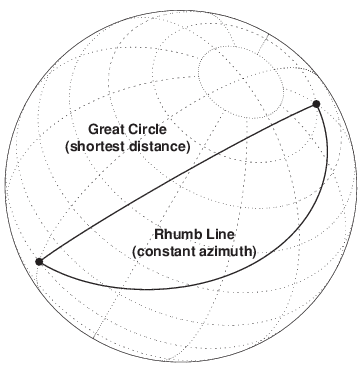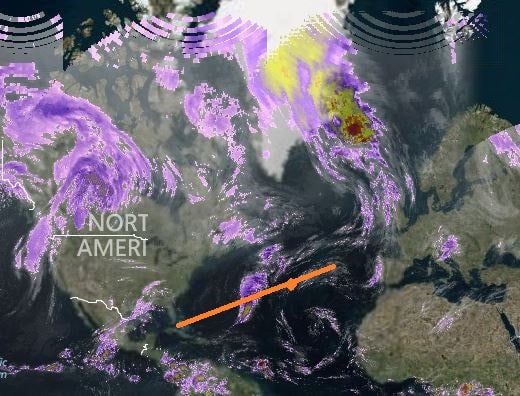Another glorious day at sea. The weather is still holding with little chance of bad weather. There is a chance of thunderstorms a bit further down the road but nothing that gives reason for real concern. So we can happily keep going on and stay on our course towards Tampa.
There are various ways to get to the same position/location when crossing the ocean. On a long distance we have two options; either going by Rhumb Line or following the Great Circle. Because the world is a globe, the shortest route is really a curved line and a straight line is longer as it has to be “stretched out” to fit over the globe. Also due to the curvature of the earth, the Great Circle line going further north as the globe is getting smaller in girth while going away from the equator. But going more north means coming closer to less pleasant weather or at least the greater chance of encountering less pleasant weather than when being further south.

Just imagine folding the globe open and pressing it flat and see what it does with the two lines. The great circle becomes a sort of short cut to the same destination. Constant azimuth means keeping the same course. With the Great Circle you make small course changes all the time to keep the curve.
The Rhumb line provides the most southerly course the ship can take and thus also staying further away from the bad weather up north. The captain has to decide between the two options. Shorter route means less fuel consumption but a heightened chance of more inclement weather and the longer route will cost more fuel but might help with finding more reasonable weather. In our case there was some inclement weather looming after day 3 from Funchal and thus the captain decided to go more south. We will have to travel an additional 15 nautical miles or so but that is much better than bouncing around in a depression. Plus if you are in a depression and the ship starts to bounce then that costs speed as well so it might not even save time.
The sailing of the Oosterdam back to the States coincided this time with a considerable change over in Officers who all joined shortly before the crossing. One lady 3rd officer was even relieved in Funchal and flew home to Holland via Lisbon. Once we get to the other side, there will be another considerable change over on the 18th. and the 24th. and after that date Deck and Engine will not much change anymore until close to Christmas. Now we have 8 sea days to enjoy, it gives an excellent time to refresh some routines which had gotten rusty or which needed some focus as during leave the focus was on other things. Thus we have now embarked on a whole program of trainings, drills and policy reviews which will help to raise the Officers awareness while doing their jobs.
One of the reasons for all this extra focus is the fact that our policies are forever being updated. Where on the shore side a law might seldom change as the political process is either very slow or a large group is against it, at sea things are different. Sailors do not have the option very much to say, this is nonsense, let’s keep it the same as we do not have any political clout. Plus it is hard to go against something that is being sold under the label “it improves safety”. But what we see going on very much in the industry is consolidation and more detailed implementation. I call it : once we walked around the building keeping to the left and now suddenly we walk around the building keeping to the right. The result is still the same. The ship still sails safely only the routines have been changed.
For the coming winter we will be sailing in the North American hemisphere and this brings with it a whole set of new rules to get used to again. Nothing really new; just different ways to approach an identical topic. It does not really matter if you fight a fire the European way or the American way (metric or imperial) the result is the same but the approach is different. For officers who are new to this or have spent the last few years in Europe and Down under, there is the challenge to get familiar with the new approach. And now we have all those sea days to accomplish this.

What we were really worried about has dissipated to the north but there is still a tail with a lot of rain and thunder and that might not be gone by the time we get there.
So while this captain is dealing with that, captain Kan is dealing with a whole set of regulatory requirements to be fulfilled in order to be allowed to sail into Tampa on the morning of the 18th. In the meantime there is also the weather to keep an eye on. Depressions are nowhere in sight for the meantime but we still have a sort of frontal system looming which might bring some thunderstorms.

November 14, 2016 at 6:28 pm
Policy updates illustrated as you did by changing sides in walking around a building works when everybody cooperates and respects the new rules. This does not work when walking on sidewalks … It would have to be a global problem with new residents and visitors alike from other countries with other customs. It is total chaos on sidewalks these days, including rudeness of walking 3 – 5 abreast without budging for oncoming “traffic”. O well; we just wait patiently for “the big crash” …
I do like your different explanation of the Rhumb Line and the Great Circle again, which is another refreshingly new way of clarifying to me.